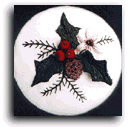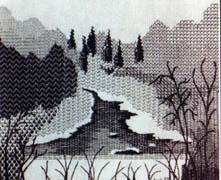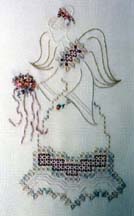Click here for her FREE ONLINE CLASS 
 Stumpwork,
a distinctive embroidery technique with the strange name whose
origin remains elusive, was popular in 17th century England.
Ultimately it fell into disfavor and remained in obscurity for
centuries. It is currently enjoying a revival and has been reintroduced
with a new spin. Karen Buell's free pattern, Holly and Berries,
featuring flowers with raised petals, a wired leaf and berries
simulated with wrapped glass pebble beads, provides an excellent
example and enticing introduction to contemporary Stumpwork design
and its execution.
Stumpwork,
a distinctive embroidery technique with the strange name whose
origin remains elusive, was popular in 17th century England.
Ultimately it fell into disfavor and remained in obscurity for
centuries. It is currently enjoying a revival and has been reintroduced
with a new spin. Karen Buell's free pattern, Holly and Berries,
featuring flowers with raised petals, a wired leaf and berries
simulated with wrapped glass pebble beads, provides an excellent
example and enticing introduction to contemporary Stumpwork design
and its execution.
Karen, whose name is pronounced Car-en in the Norwegian manner,
was an Iverson before marriage, her Scandinavian heritage mixed
with German and English. Both parents were teachers who encouraged
her to express herself artistically. They recognized in her a
talent for music and Karen studied piano and flute. In retrospect
she states that she has always been more comfortable expressing
herself through needlework than music, but she has not abandoned
it. Her instrument of choice is now a soprano recorder and she
occasionally she performs with other recorder musicians in Renaissance
costume. Artistic talents have also passed on to both her children:
Scott, a mechanical engineer with two children of his own, and
Tena, a social worker continuing her studies in grad school.
 Karen's
odyssey in needlework began with learning to knit, crochet and
embroider from both grandmothers. Because they did not live close
by, Karen was left to her own devices and she learned to use
books and kits to augment their lessons. This was no simple task
as she was taught by them without using formal directions - to
make a glove, one would simply trace a hand on paper and begin
to knit. But it turned out to be the crewel kits, especially
those of Erica Wilson, popular in the 1960's and 70's, which
piqued her fascination with stitches, techniques and texture.
Karen's
odyssey in needlework began with learning to knit, crochet and
embroider from both grandmothers. Because they did not live close
by, Karen was left to her own devices and she learned to use
books and kits to augment their lessons. This was no simple task
as she was taught by them without using formal directions - to
make a glove, one would simply trace a hand on paper and begin
to knit. But it turned out to be the crewel kits, especially
those of Erica Wilson, popular in the 1960's and 70's, which
piqued her fascination with stitches, techniques and texture.
 Upon
graduating from the University of Wisconsin, Karen taught for
a few years before marrying Doug, whom she has known since high
school. His job as a mining engineer prompted their move to Northern
MN, near the Mesabi Iron Range. Karen reminisces: "When
my children were small, I found needlework to be very rewarding.
The creative energy I put into it was something I could see at
the end of the day. It seemed everything else I did was eaten,
soiled or in some way had to be done over again." Because
stitching was such a vital part of her life, Karen organized
a group of stitchers and arranged for an out-of-town teacher.
When this contract expired, her fellow classmates gave Karen
their vote of confidence as their new teacher, initiating her
professional needlework career. That was 1974. Karen taught at
the recreation department and at a small shop, The Owl's Perch.
Once her classes were established, she decided to pursue more
studies herself, joining the NeedleArt Guild of Duluth and enrolling
in workshops. She enthuses about her next discovery: "What
a find! Through the Council of American Embroiderers Correspondence
School, I took Beginning, Intermediate and Advanced Surface Stitchery
and was certified as a teacher in 1979. These courses not only
taught the stitches and creative variations beyond crewel or
any particular technique, but included design and color while
encouraging all work to be self-designed."
Upon
graduating from the University of Wisconsin, Karen taught for
a few years before marrying Doug, whom she has known since high
school. His job as a mining engineer prompted their move to Northern
MN, near the Mesabi Iron Range. Karen reminisces: "When
my children were small, I found needlework to be very rewarding.
The creative energy I put into it was something I could see at
the end of the day. It seemed everything else I did was eaten,
soiled or in some way had to be done over again." Because
stitching was such a vital part of her life, Karen organized
a group of stitchers and arranged for an out-of-town teacher.
When this contract expired, her fellow classmates gave Karen
their vote of confidence as their new teacher, initiating her
professional needlework career. That was 1974. Karen taught at
the recreation department and at a small shop, The Owl's Perch.
Once her classes were established, she decided to pursue more
studies herself, joining the NeedleArt Guild of Duluth and enrolling
in workshops. She enthuses about her next discovery: "What
a find! Through the Council of American Embroiderers Correspondence
School, I took Beginning, Intermediate and Advanced Surface Stitchery
and was certified as a teacher in 1979. These courses not only
taught the stitches and creative variations beyond crewel or
any particular technique, but included design and color while
encouraging all work to be self-designed."  After
certification Karen also became a correspondence teacher until
that school closed. When the shop she was teaching at closed,
Karen joined an artists' co-op which provided her with classroom
space. When the co-op closed, Karen found her own shop, incorporating
class space
After
certification Karen also became a correspondence teacher until
that school closed. When the shop she was teaching at closed,
Karen joined an artists' co-op which provided her with classroom
space. When the co-op closed, Karen found her own shop, incorporating
class space  with
a small retail area. See a pattern emerging? As each placed closed
its doors, Karen tenaciously persisted in finding a new door
to open to take it's place. Karen now maintains her primary business
location in her own home in Hoyt Lakes, MN; her classes are held
at the shop in Virginia, MN and at the Recreation Department,
which provides her with an enviable arrangement - where else
can you find a small community which subsidizes needlework instruction
so that participants need only pay $1.00 per class plus supplies!
With this kind of support and Karen's reputation it's easy to
see why her classes draw students from as far and wide.
with
a small retail area. See a pattern emerging? As each placed closed
its doors, Karen tenaciously persisted in finding a new door
to open to take it's place. Karen now maintains her primary business
location in her own home in Hoyt Lakes, MN; her classes are held
at the shop in Virginia, MN and at the Recreation Department,
which provides her with an enviable arrangement - where else
can you find a small community which subsidizes needlework instruction
so that participants need only pay $1.00 per class plus supplies!
With this kind of support and Karen's reputation it's easy to
see why her classes draw students from as far and wide.
Karen has always had loyal core group of students so that
it was constantly necessary for her to create new designs as
teaching tools. Along with her talent, her intensive training
in creative stitchery gave her the confidence to experiment.
By 1980 she had accumulated a sizeable inventory of designs.
A light dawned: possibly they would appeal to others. She explains:
"Most of my teaching was in counted thread work; Hardanger,
Blackwork, Pulled and Drawn Thread work. There seemed to be little
of this on the market and perhaps I could fill this niche."
Karen began by procuring a mailing list of needlework shops and
approached them offering her designs as either chart packs or
kits. Not all of Karen's teaching projects make it to market,
but every design that does, has been a class first. Karen's students
provide a much appreciated "proofing" team. Absolutely
essential to this endeavor is Doug, who does all the photography,
from the full color print on the cover, to the closeups which
supplement the text.
 Karen
derives inspiration for her designs from the seasonal vistas
and scenic vignettes of northern Minnesota; a lone pine tree,
a winter landscape, a butterfly, a chickadee - all be found in
her work. Researching regional or historic techniques is another
passion. In pursuing ethnic stitchery new designs emerge: a Danish
Hedebo angel, Schwalm embroidery and Stumpwork. Karen discovered
Stumpwork and Schwalm embroidery through the Australian publications
Inspirations and Embroidery, Jane Nicholas' book, Stumpwork Embroidery
and 2 books by Barbara Hirst.
Karen
derives inspiration for her designs from the seasonal vistas
and scenic vignettes of northern Minnesota; a lone pine tree,
a winter landscape, a butterfly, a chickadee - all be found in
her work. Researching regional or historic techniques is another
passion. In pursuing ethnic stitchery new designs emerge: a Danish
Hedebo angel, Schwalm embroidery and Stumpwork. Karen discovered
Stumpwork and Schwalm embroidery through the Australian publications
Inspirations and Embroidery, Jane Nicholas' book, Stumpwork Embroidery
and 2 books by Barbara Hirst.  Stumpwork
is dimensional embroidery which was often executed as a culmination
of a young girl's needlework education to show off her expertise
in a variety of needlework techniques. It can include crewel
and other stitches, canvas work, gold work and often includes
embroidery which is attached to the main piece as a wired structure
or a textured applique. The old Danish Hedebo is a whitework
technique which is the form most akin to Hardanger. Similar threads
are used and cut and filling stitches are also alike. The biggest
difference is that in Danish Hedebo, the outline of the design
is a curved shape whereas Hardanger designs are primarily geometric
and angular. Schwalm embroidery is native to the Schwalm River
Valley in northern Germany. It is a surface embroidery, traditionally
white-on-white, which includes drawn fillings somewhat like those
in Hardanger, old Danish Hedebo and/or Russian groundwork, but
often incorporates more surface embroidery. The subject matter
of Schwalm embroidery usually consists of hearts and flowers,
depicted in a stylized and frequently geometric manner.
Stumpwork
is dimensional embroidery which was often executed as a culmination
of a young girl's needlework education to show off her expertise
in a variety of needlework techniques. It can include crewel
and other stitches, canvas work, gold work and often includes
embroidery which is attached to the main piece as a wired structure
or a textured applique. The old Danish Hedebo is a whitework
technique which is the form most akin to Hardanger. Similar threads
are used and cut and filling stitches are also alike. The biggest
difference is that in Danish Hedebo, the outline of the design
is a curved shape whereas Hardanger designs are primarily geometric
and angular. Schwalm embroidery is native to the Schwalm River
Valley in northern Germany. It is a surface embroidery, traditionally
white-on-white, which includes drawn fillings somewhat like those
in Hardanger, old Danish Hedebo and/or Russian groundwork, but
often incorporates more surface embroidery. The subject matter
of Schwalm embroidery usually consists of hearts and flowers,
depicted in a stylized and frequently geometric manner.
 The
Caron Collection threads have been an integral part of Karen's
work for almost 10 years. The more subtle Watercolour threads
work wonderfully for her Hardanger pieces and the addition of
Wildflowers and Waterlilies has enabled Karen to use the overdyed
threads for entire compositions. Karen adds: "I have designed
a couple of larger samplers recently and found the silk Soie
Cristale threads to be not only beautiful, but enjoyable to work
with. Then along came Stumpwork where I find the silk flosses
to be a perfect way to blend the fine threads into a dimensional
and realistic flower, leaf or berry."
The
Caron Collection threads have been an integral part of Karen's
work for almost 10 years. The more subtle Watercolour threads
work wonderfully for her Hardanger pieces and the addition of
Wildflowers and Waterlilies has enabled Karen to use the overdyed
threads for entire compositions. Karen adds: "I have designed
a couple of larger samplers recently and found the silk Soie
Cristale threads to be not only beautiful, but enjoyable to work
with. Then along came Stumpwork where I find the silk flosses
to be a perfect way to blend the fine threads into a dimensional
and realistic flower, leaf or berry."
 Karen
is emphatic about the immense joy and satisfaction she derives
from designing, stitching and sharing her expertise with others.
Her goals emphasize her priorities: "I strive to make designs
which appeal, and to write directions which are clear enough,
to guide a beginner through a new technique or design. I do enjoy
people and find that teaching is truly "in my blood.'"
Stitchers, especially beginners, often prefer projects which
can be completed relatively quickly; an ornament fits the bill
perfectly, but how many Christmas ornaments can one make? Karen's
creative solution was her Danish Hedebo Egg Ornaments, perfectly
suited to Easter and springtime decoration. These eggs are so
special and unusual, they truly make one itch to stitch.
Karen
is emphatic about the immense joy and satisfaction she derives
from designing, stitching and sharing her expertise with others.
Her goals emphasize her priorities: "I strive to make designs
which appeal, and to write directions which are clear enough,
to guide a beginner through a new technique or design. I do enjoy
people and find that teaching is truly "in my blood.'"
Stitchers, especially beginners, often prefer projects which
can be completed relatively quickly; an ornament fits the bill
perfectly, but how many Christmas ornaments can one make? Karen's
creative solution was her Danish Hedebo Egg Ornaments, perfectly
suited to Easter and springtime decoration. These eggs are so
special and unusual, they truly make one itch to stitch.
Karen Buell Designs are distributed by Nordic Needle in Fargo,
ND and Norsk Engros in Decorah, IA. She also sell direct to retail
customers . A website is a definite goal and would incorporate
a series of online classes, though Karen readily admits: "I
still like the contact with people in a class setting...It will
be interesting to see what the trends are in the future. Will
the majority of needleworkers prefer a live class setting, or
will the Internet become the avenue for learning? I suspect both
will always have a place." And we suspect that Karen Buell
Designs will always have a place as well.
Karen Buell Designs are available at most needlework shops
around the country. For more information she can be contacted
at:
Karen Buell Designs
Lakeview Drive
Hoyt Lakes, MN 55750
phone: 218-225-3102
e-mail: kdbuell@rangenet.com
